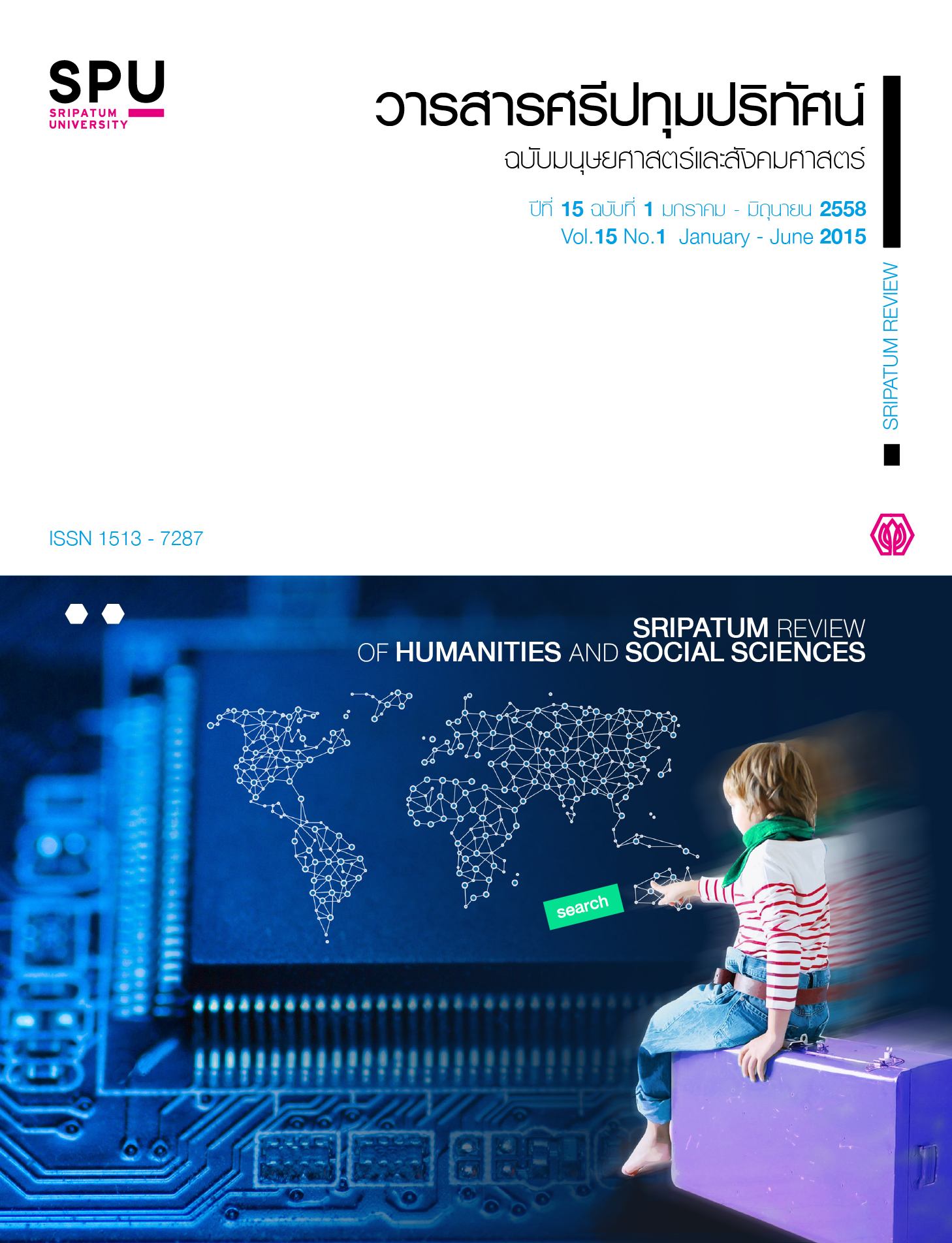THE MODEL OF COMMUNICATION FOR MEDIA AND INFORMATION LITERACY FROM THE INTERNET OF THAI YOUTHS
Main Article Content
Abstract
The key objective of this research was to propose a model of communication for media and information literacy from the Internet of Thai youths. The sample consisted of 52 first-year undergraduate students studying in the second semester of academic year 2013 at Huachiew Chalermprakiat University who were experienced Internet users. They were randomly selected from those who enrolled in four general-education courses; then they were divided into 4 groups of 13 students. The data were collected by questionnairing, testing, focus group discussion, informal interviews, observation, and discussion with the experts. The data were analyzed with the chi-square test, independent samples t-test, and content analysis. The research results were that the proposed model of communication for media and information literacy comprised three main components: (1) the main form of communication which was focused on interpersonal communication; (2) the main communication strategy which was focused on contents in teen dramas; and (3) The key media which was focused on using the Internet, especially the websites that were appropriately designed.
Article Details
1. กองบรรณาธิการสงวนสิทธิ์ในการพิจารณาและตัดสินการตีพิมพ์บทความในวารสาร
2. บทความทุกเรื่องจะได้รับการตรวจสอบทางวิชาการโดยผู้ทรงคุณวุฒิ แต่ข้อความและเนื้อหาในบทความที่ตีพิมพ์เป็นความรับผิดชอบของผู้เขียนแต่เพียงผู้เดียว มิใช่ความคิดเห็นและความรับผิดชอบของมหาวิทยาลัยศรีปทุม
3. การคัดลอกอ้างอิงต้องดำเนินการตามการปฏิบัติในหมู่นักวิชาการโดยทั่วไป และสอดคล้องกับกฎหมายที่เกี่ยวข้อง
References
จินดารัตน์ บวรบริหาร. 2548. "รู้ท่าทันสื่ออินเทอร์เน็ต การประเมินความเสี่ยงและพฤติกรรมการป้องกันตัวเองของนักเรียนชั้นมัธยมปลายในเขตกรุงเทพมหานคร" วิทยานิพนธ์มหาบัณฑิต ภาควิชาวารสารสนเทศ คณะนิเทศศาสตร์ จุฬาลงกรณ์มหาวิทยาลัย.
จันทร์ฉาย วีระชาติ. 2553. “การรู้สารสนเทศมหาวิทยาลัยบูรพา” สืบค้นเมื่อวันที่ 22 กันยายน 2555.
น้ำทิพย์ วิภาวิน. 2552. การรู้เรื่องการอ่าน การรู้สารสนเทศ และการรู้เท่าทันเทคโนโลยีสารสนเทศ วารสารบรรณศาสตร์ มศว.ปีที่2: 109-123.
ประพิมพ์พรรณ สุวรรณกูฏ. 2552. ผลกระทบของอินเทอร์เน็ตต่อสุขภาพกายและสุขภาพจิตของเด็กและเยาวชนไทย: กรณีศึกษากรุงเทพมหานคร ร่วมกับ สำนักทดสอบทางการศึกษาและจิตวิทยา มหาวิทยาลัยศรีนครินทรวิโรฒ.
ปิยฉัตร ล้อมชวการ และกมลรัฐ อินทรทัศน์. 2555.“เครื่องมือการรู้เท่าทันสื่อและสารสนเทศ” และ “รู้จักสื่อ รู้ใช้สาร อย่างสร้างสรรค์” ศูนย์วิจัยการจัดการความรู้การสื่อสารและการพัฒนา (CCDKM) มหาวิทยาลัยสุโขทัยธรรมาธิราช.
พรทิพย์ เย็นจะบก. 2552. ถอดรหัส ลับความคิดเพื่อการรู้เท่าทันสื่อ: คู่มือการเรียนรู้เท่าทันสื่อ.กรุงเทพมหานคร: ออฟเซ็ท ครีเอชั่น.
วาลี ขันธุวาร. 2551. “การรู้เท่าทันสื่อของนักศึกษามหาวิทยาลัยขอนแก่น” ฝ่ายวิจัยและบริการวิชาการ คณะมนุษยศาสตร์และสังคมศาสตร์ มหาวิทยาลัยขอนแก่น.
วรัชญ์ ครุจิต และ ฉัตรฉวี คงดี. 2554. การสำรวจการเรียนการสอนความรู้เท่าทันสื่อในสถาบันอุดมศึกษาในประเทศไทย คณะนิเทศศาสตร์ มหาวิทยาลัยศรีปทุม แผนงานสื่อสร้างสุขภาวะเยาวชน (สสย.)
ศิริพรรณ สายหงส์. 2553. ทักษะชีวิต (Life skill) มหาวิทยาลัยเทคโนโลยีราชมงคลล้านนา ลำปาง สืบค้นเมื่อวันที่ 3 พฤษภาคม 2556.
ศิริชัย พงษ์วิชัย. 2553. การวิเคราะห์ข้อมูลทางสถิติด้วยคอมพิวเตอร์ กรุงเทพฯ: สำนักพิมพ์แห่งจุฬาลงกรณ์มหาวิทยาลัย.
สะอาด ไปล่โสภณ. 2552. “พฤติกรรมและปัญหาการใช้อินเทอร์เน็ตของนักศึกษามหาวิทยาลัยราชภัฏพระนครศรีอยุธยา” วิทยานิพนธ์ศิลปศาสตรมหาบัณฑิต สาขาสังคมศาสตร์เพื่อการพัฒนา มหาวิทยาลัยราชภัฏพระนครศรีอยุธยา.
เอื้อจิต วิโรจน์ไตรรัตน์. 2540. “การวิเคราะห์ระดับมีเดียลิตเตอเรซีของนักศึกษาระดับอุดมศึกษาในประเทศไทย” วิทยานิพนธ์ปริญญาครุศาสตรดุษฎีบัณฑิต สาขาวิชาเทคโนโลยีและสื่อสารการศึกษา ภาควิชาโสตทัศนศึกษา คณะครุศาสตร์ จุฬาลงกรณ์มหาวิทยาลัย.
อุมาพร ตรังคสมบัติ. 2544. จิตบำบัดและการให้คำปรึกษาครอบครัว (Family therapy of family counseling) กรุงเทพฯ: ศูนย์วิจัยและบำบัดครอบครัว.
อุไร สุมาริธรรม. 2545. จิตวิทยาวัยรุ่น กรุงเทพมหานคร: คณะครุศาสตร์. จุฬาลงกรณ์มหาวิทยาลัย.
อุษา บิ้กกิ้นส์. 2554. “ทักษะการรู้เท่าทันสื่อ เทคนิคขั้นตอนในการรู้เท่าทันสื่อและการวิเคราะห์สื่อ” แหล่งเรียนรู้เท่าทันสื่อและสารสนเทศแห่งประเทศไทย สืบค้นเมื่อวัน17เมษายน 2556.
Berlo, D. K. (1960). The process of communication. New York, New York: Holt, Rinehart, & Winston.
Bandura, A., & Walter, R.H. 1963. Social learning and personality development. New York: Holt, Rinehart, & Winston.
Eisenberg, M. B. & Berkowitz, R. E. 1990. “Information problem solving: The Big Six Skills approach to library and information skills instruction.” Norwood, NJ: Ablex. Ablex Publishing Corporation, NJ 07648.
Jones, Steve. 2002. “The Internet goes to college: How students are living in the future with today's technology. Internet & American Life” Retrieved August 23, 2012.
Katz, E., J.G. Blumler and M. Gurevitch. 1974. Utilization of mass Communication by the individual in Blumer revisited, in J. G. Blumer and E. Katz. Bevery Hills : Sage Publication.
Krikelas, James. Information-seeking behavior: patterns and concepts En: Drexel Library Quarterly, vol. 19, no. 2, (spring 1993) p. 5-20.
Maxwell E. McCombs, Lee B. Becker. 1979. Using Mass Communication Theory. Engllwood Cliffs N. J. Prentice Hall.
Moscow Déclaration. 2012. MIL in Knowledge Societies. Publisher: Interregional Library Cooperation Centre, Moscow.
Papert, S. & Harel, I. (eds). 1991. Constructionism: research reports and essays 1985 - 1990 by the Epistemology and Learning Research Group, the Media Lab, Massachusetts Institute of Technology, Norwood, NJ.
Potter, W. J. 2005. Media literacy (3rd ed.). Thousand Oaks, CA: Sage.
Schramm, W. 1954. ‘How communication works’ in Schramm W (ed.) The Process and Effects of Mass Communication. Urbana University of Illinois Press.


